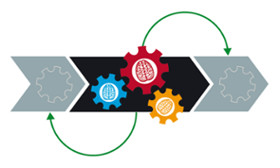Getting the Most Out of an Integrated Supply Chain
Brian Hoey - June 14, 2018

 Imagine for a second that you’re an NFL quarterback: you have a plan to throw a forward pass to one of your wide receivers, to whom you’ve dictated a specific pass route. Unfortunately, you’ve neglected to inform any of your other teammates of what you plan to do. Even worse, you haven’t bothered to ask any of your fellow players if they have plans of their own and, if so, how they might conflict with the plan you’ve devised. As a result, when something goes awry, none of your teammates are able to make adjustments on the fly, and your plan has no way of overcoming whatever hurdles crop up.
Imagine for a second that you’re an NFL quarterback: you have a plan to throw a forward pass to one of your wide receivers, to whom you’ve dictated a specific pass route. Unfortunately, you’ve neglected to inform any of your other teammates of what you plan to do. Even worse, you haven’t bothered to ask any of your fellow players if they have plans of their own and, if so, how they might conflict with the plan you’ve devised. As a result, when something goes awry, none of your teammates are able to make adjustments on the fly, and your plan has no way of overcoming whatever hurdles crop up.
The alternative to this plan is to have a coach or manager draw up the plays and communicate them in an open and visible manner to every member of the team, gaining an understanding of each player’s tendencies and intentions in the process. It’s easy to see why this tactic would yield more fruitful results: with all of your players on the same page and aware of what one another are doing, it’s suddenly possible to carry out a more coordinated response to any potential disruptions, with individual players being sufficiently well informed that they can act of their own initiative to save the play.
For our purposes, this alternative planning format is roughly the equivalent of an integrated supply chain (i.e. a supply chain in which all processes and operations are connected, often via digital workflows). But while an integrated supply chain is certainly more efficient than the alternative, many businesses don’t extract maximum value from their supply chain integration. McKinsey found that large-scale IT changes often cost twice as much and produce half as much value as businesses anticipate, and this is likely equally true of IT surrounding integration attempts. This all begs the question: how do you get the most out of an integrated supply chain?
Real-Time
To begin with, one of the most mission critical goals of an integrated supply chain must be to improve visibility and data accessibility. To this end, the putting in place of the necessary IT infrastructure (and removing the necessary silos) to make real-time information available is a virtual guarantee that you are not just centralizing your integrated data, but positioning it as a meaningful value driver. With real-time information available intra-operationally, planners can create better informed plans while responding in a more agile manner to disruptions and slowdowns. The more current the information, the more likely it is that the maximum amount of value will be preserved in the event of a vehicle or machine breakdown, a capacity shortage, or a sudden demand spike.
S&OE
Once real-time information is accessible intra-operationally, it’s possible to introduce a sales & operations execution (S&OE) workflow into your value stream. S&OE, which refers to the process of monitoring and adjusting to daily and weekly fluctuations in demand in order to keep mid-term, operational plans on track, utilizes up-to-the-minute information on demand and fuel pricing in order to tweak transport plans and inventory levels as needed. In this way, manufacturers avoid overages and shortages while maintaining an accurate picture of their supply stream and demand scenarios.
As is the case with real-time, the ability to perform this process is both a measure of successful integration and an example of how to maximize value. By optimizing basic processes while increasing transparency, S&OE turns integration into increased agility and adaptability throughout the entire value chain. Where supply chains that feature lower degrees of integration might find that monthly or quarterly planning workflows result in large discrepancies between projected outcomes and reality, S&OE ensures that expectations are continually adjusted to reflect changing conditions. Many businesses seeking to achieve supply chain integration find that they struggle to create a truly visible and collaborative environment, but S&OE can go a long way towards alleviating that hurdle.
Advanced Analytics
As we’ve discussed previously, the benefit of supply chain integration is the centralization of mission critical data from all touchpoints on the value stream. Thus, the question of getting the most out of your integration is intertwined with the question of how to get the most out of your data. With regards to the latter question, one of the most powerful tools that a supply chain manager can utilize is advanced analytics. By introducing predictive and prescriptive analytics into an integrated supply chain, businesses can turn newly-centralized data from across the supply stream into improved forecasts and actionable, value-added insights. In many ways, these processes will build on the work being done by S&OE to decrease the discrepancy between forecasts and reality. At the same time, advanced analytics represents a whole new paradigm for getting value from your data. Not only does it help alleviate the hurdles resulting from poor visibility, it maximizes the strength of your supply chain integration.
LATEST POSTS
- Understand Circular Economy in The Manufacturing Industry
- How Can Industry 4.0 IT Integration Be Achieved Smoothly?
- The Significance of Order Sequencing in Discrete Manufacturing
- How to improve your Supply Chain Management: The Power of Control Towers
- Optimizing Human Resource Scheduling in Manufacturing: A Technological Approach



